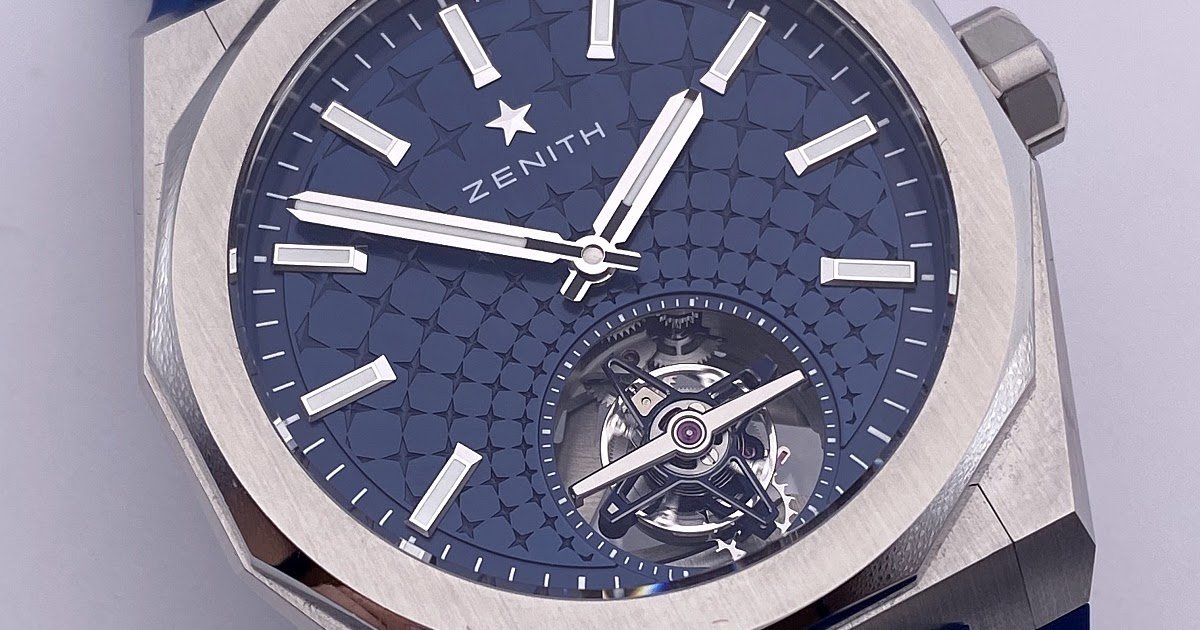The presentation of the Defy Skyline Tourbillon a few weeks ago confirms the key role of the Skyline collection within the Zenith catalogue. Little by little, it is gaining momentum and, due to the release of this latest model, its price range is significantly expanding upwards. It is certainly not a real surprise to discover a tourbillon in this context, but Zenith still had to succeed in its integration. I think that the Locle manufacture has succeeded in doing so effectively.
To be honest, I don’t think the result has many surprising elements. The case diameter remains at 41mm and the main aesthetic components (index, hands, crown etc…) are similar to those of the 3-hand versions with date. There is of course a desire to rationalize the approach on Zenith’s part but this consistency also contributes to strengthening the identity of the collection. In addition, when a more prestigious model, such as a tourbillon version, is presented, this can have a positive impact on the rest of the collection.
In any case, what had to be done was done well. First of all, Zenith made sure to change the geometry of the dial pattern. This point is essential. If Zenith had kept a dial identical to the 3-hand version with date, the open area dedicated to the tourbillon would have seemed inappropriate because it combined a circle with lines intersecting at right angles. Thanks to a dial structure using sunbeams that start from the tourbillon cage, the whole appears harmonious and dynamic with a feeling of convergence towards the outside. Then, Zenith avoided superfluous details to focus on the essential. The tourbillon bridge is reduced to its simplest expression and does not exceed the opening (which I generally prefer). This allows our gaze to focus on the star-shaped cage. In fact, observing the tourbillon is very pleasant. The cage is nicely executed and is clearly distinguished from the regulating organ. It makes a complete rotation in one minute, which is very often the norm for a tourbillon. What is less known is the frequency of the movement: 5hz. It is thus important to remember that this Zenith Defy Skyline Tourbillon is a very rare example of a high-frequency tourbillon watch. This is not often said and it is a shame.
The movement is indeed an El Primero 3630 caliber which offers a power reserve of 60 hours for a frequency of 5hz. The power reserve remains generous despite the consumption of the energy necessary for the revolution of the tourbillon cage. However, the mass of the latter has been controlled (0.25g) which has made it possible to maintain a power reserve similar to that of the El Primero 3620 caliber of the 3-hand version with date. The presentation of the movement remains sober and neat, in the spirit of the collection. I really appreciated that the main bridge is decorated with ribs that take up the sunburst pattern of the dial. This denotes an attention to detail. However, I would have liked Zenith to be a little more daring with the oscillating weight in order to mark a deeper difference with the other models in the collection. It is still a tourbillon watch and it deserves more differentiating factors in my opinion, prestige requires.
Regardless, the Defy Skyline Tourbillon is a very easy-going watch. Tourbillons have long been a thing of the past for classic watches, and this Zenith proves it once again. The case is water-resistant to 100 meters and is equipped with the handy quick-change strap system, allowing you to easily switch between a metal strap and a rubber strap.
The Defy Skyline Tourbillon is available in two versions: steel with a blue dial or black ceramic with a black dial. I have a clear preference for the first. First of all, because of their prices (59,600 euros vs. 70,400 euros). Then, because of their respective renderings. The steel version with a blue dial is, in my opinion, more lively, more dynamic, more sporty. The other model is more elegant and even if the dominant black color reduces the perceived size, it remains a bulky watch. The integrated bracelet also accentuates this impression of size. This is why I think that the more casual style of the steel version is more appropriate. In addition, the tourbillon bridge is more visible on the ceramic version and tends to take precedence over the cage. I prefer the opposite approach of the steel version because the cage is for me the major element that must be highlighted the most.
The black ceramic version that I like less because it highlights the cage less:
I ultimately liked the Zenith Defy Skyline Tourbillon, especially in its steel version. I think that this version offers solid watchmaking content for a fairly reasonable price. It is still a tourbillon watch from one of the finest Swiss manufacturers and the fact that this price is below 60,000 euros reinforces its attractiveness. The watch is practical, versatile and allows you to enjoy a high-frequency tourbillon in all circumstances. Even if its execution is not surprising and it would surely have deserved a little more audacity, the Zenith Defy Skyline Tourbillon remains a credible proposition with no real weak points. My only regret is that Zenith did not adopt a more ambitious approach to the decoration of the movement to bring a little touch of exuberance that would have been welcome.
The pros:
+ one of the rare 5hz tourbillon movements on the market
+ an attractive price for the steel version considering the watch content
+ versatility (waterproofing and quick strap change system)
The cons:
– a case that remains bulky
– a decorative style of the movement too sober for my taste for a tourbillon watch
